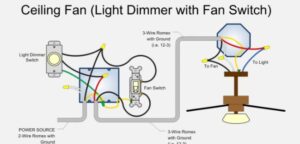Ceiling fans, just like any other electronic has to be wired appropriately. That is to guarantee the smooth flow of the electrical current and enable the system to work hassle-free.
As a user of these appliances, you must know the ceiling fan wiring diagram. We care to explain the four major wires that the wiring contains.

Types of Ceiling Fan Wires Explained
To accomplish this aim, we highlight and examine the four major wires that such fans do possess. These include the blue, black, white, and red wires, respectively.
In our ceiling fan wiring diagram explanations here, we shed more light on what each wire stands for and the areas of applications they may be dedicated to.
Blue wire
The blue works alongside the yellow color. These two are used to carry and relay electrical power but not for sharing the same with the various plug-ins or across the outlets.
It is largely used to carry and transmit the live voltage that is subsequently passed through some conduits.
Additionally, the blue wire takes away electricity from the appliances. In this way, it ensures the smooth circulation of the current and stifles the appliances’ ability to sustain shocks or voltage spikes.
Lastly, it works alongside the brown wire to complete a circuit and enable smoother operations.
The blue wire’s existence gives you the power to operate the light and the fan power interdependently.
This arrangement is great as it prevents any confusion that may subsequently lead to the electronic appliance’s permanent or possible electrocution altogether.
Black wire
The black wire is the live component of the electrical circuit. It is the one that draws the power from the mains outlet and transmits the same to the power supply unit of the electronic concerned.
For this reason, it is by far the most dangerous and riskiest of all the major wires that a circuit contains.
It hence should never be used as a neutral or ground wire as a result of this. Since it runs from the mains outlet to the electronic power supply unit, it may also be used as a switch.
In this sense, it is used to regulate the flow of the electrical energy to the system and the performance of the same altogether.
Considering the sensitive role that this black wire plays, it may never be accessed anyhow. Instead, only the qualified, well-armed, and equipped electrician should be allowed to handle it.
The same goes for any exposure between it and the ‘outside world.’

White wire
Works hand in hand with the gray colors. Together, they jointly signify neutrality. The purpose of a neutral wire is to channel back to the circuit breaker any unused or excess electrical energy.
That way, it prevents the possibility of the system blowing up when engaged for use.
Other than this core role, the neutral wire also attaches to the bus bar. It is this bar that distributes the electrical energy to the feeders.
The use of the white color is in tandem with the convention that black symbolizes peace and tranquility.
After returning the excess current to the electrical components, the wire runs deep and straight to the ground for anchoring and eventual dissipation.
That stems from the fact that the ground is normally at zero potential or in a position of complete neutrality.
Red wire
Red wires are also christened secondary live wires. They, unlike their black counterparts, are largely found in the multi-conductor and sheathed cables.
These wires are mainly attached to the switch wiring and pair with the smoke-detectors or the power systems. In a ceiling fan, they are used to up the flow of power in the system.
Typically, this red wire attaches to the ceiling that attaches to the black wire in the light kit and then back to the fan.
An ordinary accommodates or holds a whopping 220 volts commonly found in large scale installations and common electrical structures.
The use of red color is strategic as it signifies danger. Anyone who beholds it is also able to stay away from the impending dangers that potentially come along.
It hence serves to scare away anyone who may cross the path of the installations or the fans wherein the same is employed.

Where Do the Four Wires Go on a Ceiling Fan?
We have belabored the four wires. Having done that, we are now going to explain where exactly these wires go to when used in the ceiling fans:
Blue wire
Since the blue color wire is used mainly to relay the electrical power within the ceiling fan circuit, it connects the electrical circuit’s various components.
These are the circuit breakers, switches, valves, regulators, and integrated circuits. It is by far the most ubiquitous of all the wires in place.
Black wire
All wires, regardless of their colors or specializations, have to pass through the mounting plates’ center hole. The black on top of that twists with that of the electrical box to guarantee a smooth flow of the wires’ electrical power.
This forms a continuous and uninterrupted operation all the while.
White wire
As explained above, this white wire alongside the other wires in the electrical circuit runs through the center hole of the mounting plate.
All the white wires are twisted together to form one monolithic avenue via which the excess current is transmitted in the entire circuit altogether.
Red wire
The red wire plays the role of furnishing extra or additional current to the entire system.
It attaches to the electrical box from whence it draws the current and then channels to the ceiling fan’s power supply unit.
Since it passes through the switch, it may also regulate the flow and the quantity of power.
How to Wire a Ceiling Fan?
Here is a video to instruct you to wire a ceiling fan by yourself safely and easily. Click for details.
After wiring the ceiling fan, you may change it solely at home without spending extra money on maintenance.
Conclusion
Knowing more about the ceiling fan wiring diagram is certainly great if you appreciate your electronics better.
That is why we recommend a careful re-read of the explanations we have given forth above. It also pays to carry out some additional experimentation to let the concepts sink in.
